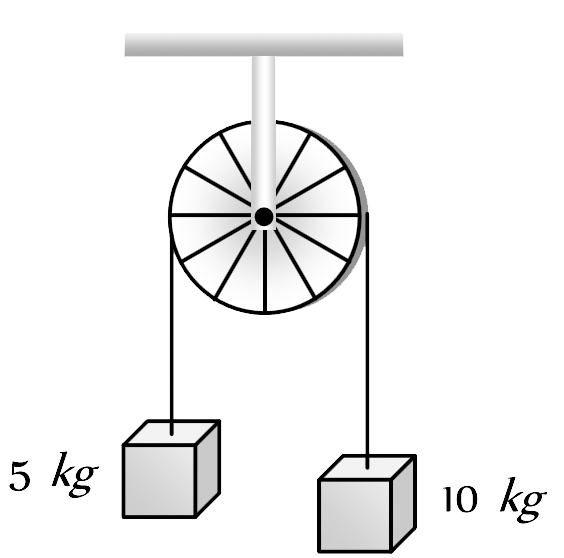The masses of 10kig and 20kg respectively are connected by a massless spring as shown in figure. A force of 200N acts on the 20kg mass. At the instant shown, the 10kg mass has acceleration 12m/sec2 . What is the acceleration of 20kg mass?
 Solution in Gujrati
Solution in Gujrati
Equation of motion for m1 is F=m1a1=10×12=120N. Force on 10kg-mass is 120N to the right. As action and reaction are equal and opposite, the reaction force F on 20kg mass F=120N to the left.
∴ Equation of motion of m2 is 200−F=20a2
⇒200−120=20a2⇒20a2=80⇒a2=8020=4ms−2
Topper's Solved these Questions
- NEWTONS LAWS OF MOTIONBOOK - ALLEN CHAPTER - NEWTONS LAWS OF MOTIONEXERCISE - SWOE
44 Videos
- NEWTONS LAWS OF MOTIONBOOK - ALLEN CHAPTER - NEWTONS LAWS OF MOTIONEXERCISE - EXERCISE-I
52 Videos
- NEWTON'S LAWS OF MOTION & FRICTIONBOOK - ALLEN CHAPTER - NEWTON'S LAWS OF MOTION & FRICTIONEXERCISE - EXERCISE (JA)
4 Videos
- RACEBOOK - ALLEN CHAPTER - RACEEXERCISE - Basic Maths (Wave Motion & Dopplers Effect) (Stationary waves & doppler effect, beats)
25 Videos
Similar Questions
A 2000 kg rocket is set for vertical firing the exhaust speed is 400 m/s to given an initial upward acceleration of 10m/s2. Find out the amount of gas ejected per second to supply the needed thrust (g=10m/s2)
View SolutionUSS 150) Two masses of 5 kg and 10 kg are connected to a pulley as shown. What will be the acceleration of the system (g= acceleration due to gravity)

View SolutionA piece of wire is bent in the shape of a parabola y=kx2 (y-axis vertical) with a bead of mass m on it. The bead can slide on the wire without friction. It stays at the lowest point of the parabola when the wire is at rest. The wire is now accelerated parallel to the x-axis with a constant acceleration a. The distance of the new equilibrium position of the bead, where the bead can stay at rest with respect to the wire, from the y-axis is:
View SolutionThe frequency of a radar is 780 MHz. After getting reflected from an approaching aeroplane, the apparent frequency is more than the actual frequency by 2.6 kHz. The aeroplane has a speed of
View SolutionThe masses of 10kig and 20kg respectively are connected by a massless spring as shown in figure. A force of 200N acts on the 20kg mass. At the instant shown, the 10kg mass has acceleration 12m//sec^(2) . What is the acceleration of 20kg mass?
View SolutionWhat acceleration is produced by a force of 5N acting on a body of mass 20kg ?
View SolutionTwo bodies A and B each of mass m are fixed together by a massless spring . A force F acts on the mass B as shown in fig .3 (a)18. At the instant shown , the body A has an acceleration a What is the acceleration of B ?

View SolutionTwo blocks of masses 5 kg and 10 kg are connected by a massless spring as shown in the diagram. A force of 100 N acts on 10kg mass as shown. At a certain instant the acceleration of 5 kg mass is 12 m//s^(2) find the force in the spring and acceleration of 10 kg mass.
View SolutionThe masses of 10 kg and 20 kg, respectively, are connected by a light spring as shown in the figure. A force of 200 N acts upon the 20 kg mass. At the instant shown, the 10 kg mass the acceleration of 12m//s^(2) . The acceleration of 20 kg mass is
View SolutionThe masses of 10 kg and 20 kg respectively are connected by a massless spring as shown in figure. A force of 200 N acts on the 20 kg mass. At the instant shown, the 10 kg mass has acceleration 12m/sec2 . What is the acceleration of 20 kg mass

View SolutionTwo blocks of masses 10kg and 20kg are connected by a light spring as shown. A force of 200N acts on the 20kg mass as shown. At a certain instant the acceleration of 10kg mass is 12 ms^(-2) towards right direction.
View SolutionTwo bodies A and B each of mass M are fixed together by a massless spring A force F acts on the mass B as shown in fig At the instant shown the mass A has acceleration a. What is the acceleration of mass B?
View SolutionTwo masses 10 kg and 20 kg respectively are connected by a massless spring as shown in figure force of 200 N acts on the 20 kg mass. At the instant shown is figure the 10 kg mass has acceleration of 12m/s2 what is the acceleration of 20 kg mass?

View SolutionTwo masses A and B each of mass M are connected together by a massless spring. A force F acts on the mass B as shown in fig. At the instant shown the mass A has an acceleration a. What is the acceleration of mass B ? (##MOD_RPA_OBJ_PHY_C04_A_E01_019_Q01.png" width="80%">
View SolutionTwo blocks of masses 10kg and' 20kg are conne-cted by a massless spring and are placed on a smooth horizontal surface. A force of 200N is applied on 20 kg mass as shown in the diagram. At the instant, the acceleration of 10kg mass is 12ms−2, the acceleration of 20kg mass is,

View SolutionTwo masses of 10kg and 20kg respectively are connected by a massless spring. A force of 200N acts on the 20kg mass. At the instant when the 10kg mass has an acceleration of 10ms−2 the acceleration of 20kg mass is _______ ms−2
View Solution
